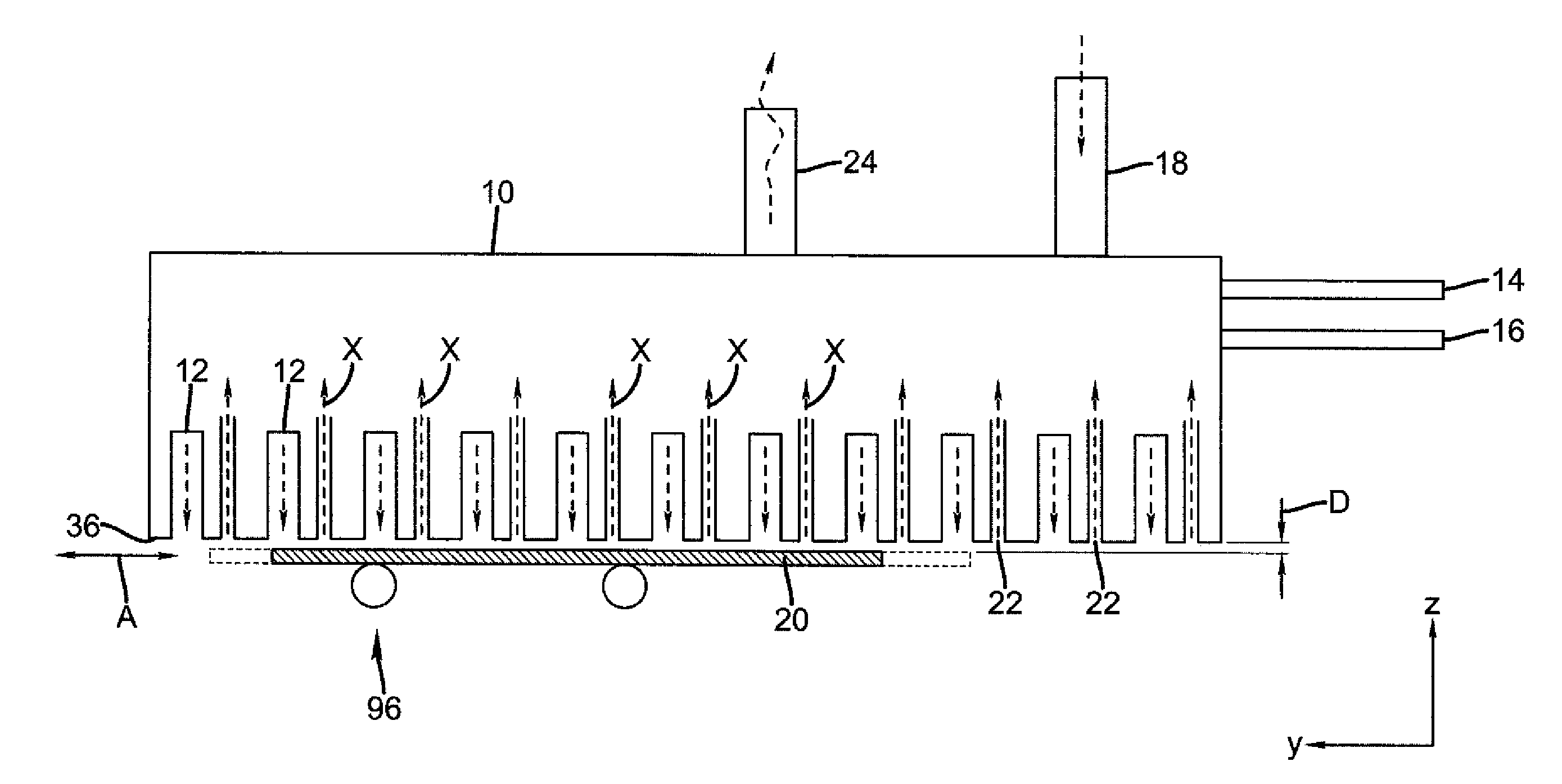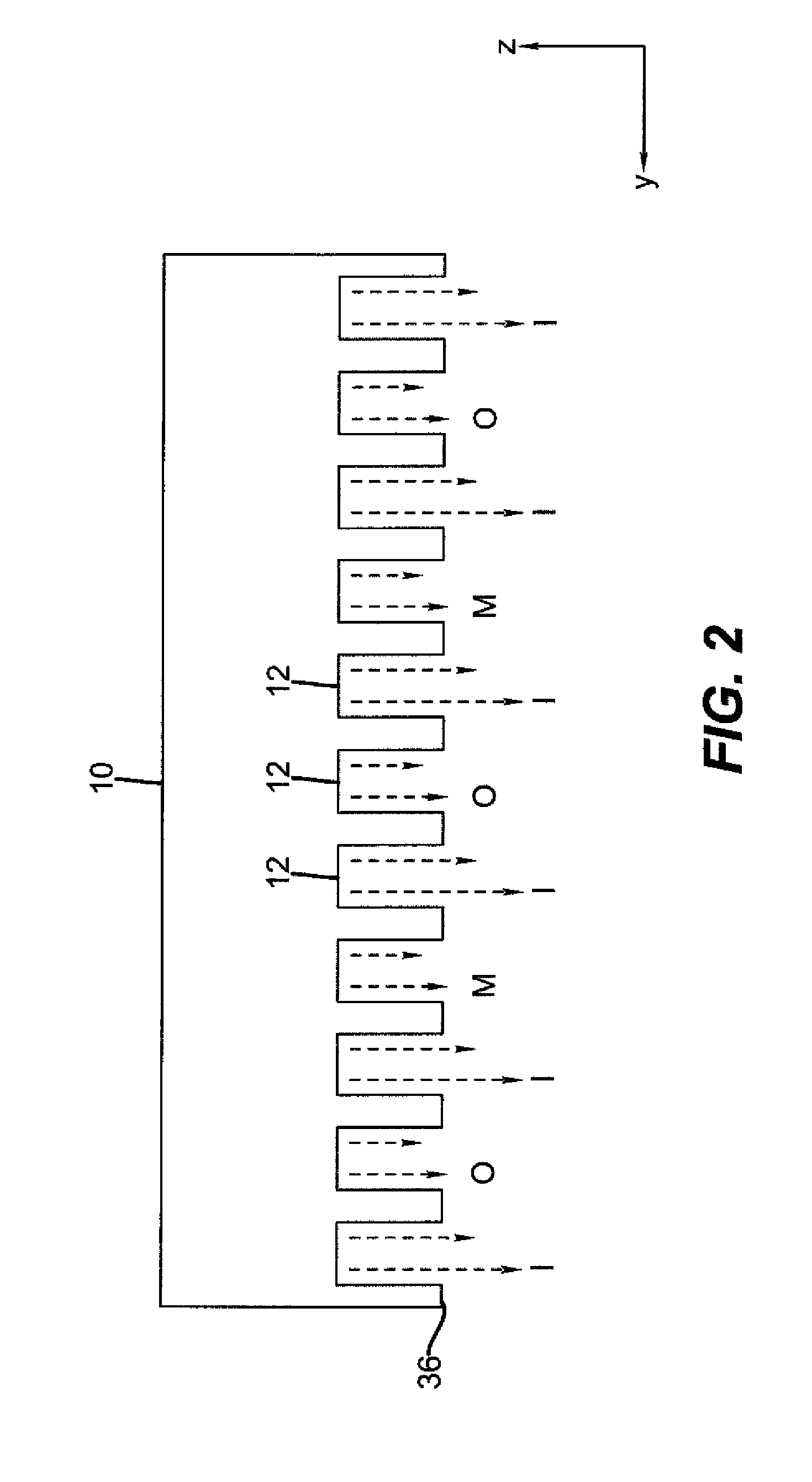System for thin film deposition utilizing compensating forces
a compensating force and thin film technology, applied in the direction of chemical vapor deposition coating, coating, semiconductor devices, etc., can solve the problems of large amount of chemical vapor deposition reaction, difficult to avoid some direct reaction of different precursors, relatively insensitive to transport non-uniformities, etc., to achieve the effect of reducing the residence tim
- Summary
- Abstract
- Description
- Claims
- Application Information
AI Technical Summary
Benefits of technology
Problems solved by technology
Method used
Image
Examples
example 1
Comparative
[0230]This example quantifies the forces acting on a substrate when the average exhaust suction is ½ of the weight per unit area of the substrate.
[0231]In this example the substrate rests on top of the deposition head such that the force of gravity acts to pull the substrate toward the deposition head.
[0232]The substrate is a piece of conventional glass with a density of 2.2 g / cm3 and a thickness of 1 mm. Based upon its area the mass of the glass will be 2.2 grams and the substrate weight, thus the gravitational force acting on the substrate, will be 0.0216 N. The weight per unit area of the substrate is therefore 21.6 Pa.
[0233]If the exhaust channel pressure is set at 10.8 Pa (0.043 in H2O) then the exhaust pressure will be / 2 of the weight per unit area of the substrate. According to equation (5) the critical force at which the substrate will separate from the head will be 0.0108 N. Since this force is substantially less than the weight of the substrate at 0.0216 N, sma...
example 2
Inventive
[0234]This example quantifies the forces acting on a substrate when the average exhaust suction is 5 times the weight per unit area of the substrate.
[0235]In this example the substrate rests on top of the deposition head such that the force of gravity acts to pull the substrate toward the deposition head.
[0236]The substrate is a piece of conventional glass with a density of 2.2 g / cm3 and a thickness of 1 mm. Based upon its area the mass of the glass will be 2.2 grams and the substrate weight, thus the gravitational force acting on the substrate, will be 0.0216 N. The weight per unit area of the substrate is therefore 21.6 Pa.
[0237]If the exhaust channel pressure is set at 108 Pa (0.43 in H2O) then the exhaust pressure will be 5 times the weight per unit area of the substrate. According to equation (5) the critical force at which the substrate will separate from the head will be 0.108 N. Since this force is substantially more than the weight of the substrate at 0.0216 N, sma...
example 3
Comparative
[0238]This example employs the same configuration as in Example 1 except that the deposition head is inverted with the substrate below the head. Therefore, the force of gravity acts to pull the substrate from the head.
[0239]This example quantifies the forces acting on a substrate when the average exhaust suction is ½ of the weight per unit area of the substrate.
[0240]The substrate is a piece of conventional glass with a density of 2.2 g / cm3 and a thickness of 1 mm. Based upon its area the mass of the glass will be 2.2 grams and the substrate weight, thus the gravitational force acting on the substrate, will be 0.0216 N. The weight per unit area of the substrate is therefore 21.6 Pa.
[0241]If the exhaust channel pressure is set at 10.8 Pa (0.043 in H2O) then the exhaust pressure will be / 2 of the weight per unit area of the substrate. According to equation (5) the critical force at which the substrate will separate from the head will be 0.0108 N. Since the gravitational for...
PUM
| Property | Measurement | Unit |
|---|---|---|
| radius | aaaaa | aaaaa |
| distance | aaaaa | aaaaa |
| temperature | aaaaa | aaaaa |
Abstract
Description
Claims
Application Information
 Login to View More
Login to View More - R&D
- Intellectual Property
- Life Sciences
- Materials
- Tech Scout
- Unparalleled Data Quality
- Higher Quality Content
- 60% Fewer Hallucinations
Browse by: Latest US Patents, China's latest patents, Technical Efficacy Thesaurus, Application Domain, Technology Topic, Popular Technical Reports.
© 2025 PatSnap. All rights reserved.Legal|Privacy policy|Modern Slavery Act Transparency Statement|Sitemap|About US| Contact US: help@patsnap.com



